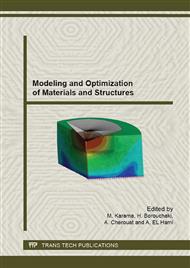[1]
Der Kiureghian A, Jyh-Bin K. The stochastic finite element method in structural Reliability. Probabilistic Engineering Mechanics 1988; 3(2): 83-91.
DOI: 10.1016/0266-8920(88)90019-7
Google Scholar
[2]
Sudret B, Der Kiureghian A. Comparison of finite element reliability methods. Probabilistic Engineering Mechanics 2002; 17: 337–348.
DOI: 10.1016/s0266-8920(02)00031-0
Google Scholar
[3]
Cacciola P, Maugeri N, Muscolino G. A modal correction method for non-stationary random vibrations of linear systems. Probabilistic Engineering Mechanics 2007; 22: 170–180.
DOI: 10.1016/j.probengmech.2006.10.002
Google Scholar
[4]
Moro T, El Hami A, El Moudni A. Reliability Analysis of a mechanical contact between deformable solids. Probabilist. Eng. Mech. 2002; 17(3): 227–232.
DOI: 10.1016/s0266-8920(02)00007-3
Google Scholar
[5]
Kleiber M, Rojek J, Stocki R. Reliability assessment for sheet metal forming operations. Computer Methods in Applied Mechanics and Engineering 2002; 191: 4511–4532.
DOI: 10.1016/s0045-7825(02)00394-8
Google Scholar
[6]
Bing L, Nye TJ, Metzger Don R. Improving the reliability of the tube-hydroforming process by the Taguchi Method. J Pressure Vessel Technology 2007; 129: 242-247.
DOI: 10.1115/1.2716427
Google Scholar
[7]
Radi, B and El Hami, A. Reliability analysis of the metal forming process. Mathematical and Computer Modelling 2007; 45: 431–439.
DOI: 10.1016/j.mcm.2006.05.013
Google Scholar
[8]
Aydemir, A et al. An adaptive simulation approach designed for tube hydroforming processes. J Materials Processing Technology 2004; 159: 303-310.
DOI: 10.1016/j.jmatprotec.2004.05.018
Google Scholar
[9]
Jansson, M, et al. On process parameter estimation for the tube hydroforming process. J Materials Processing Technology 2007; 190: 1-11.
DOI: 10.1016/j.jmatprotec.2007.02.050
Google Scholar
[10]
Fann, K-J. and P-Y. Hsiao. Optimization of loading conditions for tube hydroforming. J Materials Processing Technology 2003; 140: 520-524.
DOI: 10.1016/s0924-0136(03)00778-7
Google Scholar
[11]
Imaninejad, M. et al. Loading path optimization of tube hydroforming process. I J Machine Tools & Manufacture 2005; 45: 1504-1515.
DOI: 10.1016/j.ijmachtools.2005.01.029
Google Scholar
[12]
Abedrabbo, N. et al. Wrinkling control in aluminum sheet hydroforming. I J Mechanical Sciences 2005; 47: 333–358.
DOI: 10.1016/j.ijmecsci.2005.02.003
Google Scholar
[13]
Mohsine A. and El Hami A. A Robust Study of Reliability-Based Optimisation Methods under Eigen-frequency. International Journal of Computer Methods in Applied Mechanics and Engineering 2010; 199(17-20): 1006-1018.
DOI: 10.1016/j.cma.2009.11.012
Google Scholar
[14]
El Hami A., Radi B. and Cherouat A. The frictional contact of the shaping of the composite fabric. International Journal of Mathematical and Computer Modelling 2009; 49: 1337-1349.
DOI: 10.1016/j.mcm.2008.09.016
Google Scholar
[15]
Cherouat A. Radi B. and El Hami A. The frictional contact of the shaping of the composite fabric. I J Acta Mecanica 2009, 199(1-4): 29-41.
DOI: 10.1007/s00707-007-0566-1
Google Scholar
[16]
Radi B. and El Hami A. Reliability analysis of the metal forming process. International Journal of Mathematical and Computer Modelling 2007; 45: 431-439.
DOI: 10.1016/j.mcm.2006.05.013
Google Scholar
[17]
Karthik V. et al. Variability of sheet formability and formability testing. J of Mat Proc Technology 2002; 121: 350–362.
DOI: 10.1016/s0924-0136(01)01219-5
Google Scholar
[18]
Gantar G, Kuzman K. Optimization of stamping processes aiming at maximal process stability. J of Mat Proc Technology 2005; 167: 237-243.
DOI: 10.1016/j.jmatprotec.2005.05.027
Google Scholar
[19]
Cao J, Krishnan N. Estimation of optimal blank holder force trajectories in segmented binders using ARMA model. J of Manuf Science and Engineering 2003; 125: 763-770.
DOI: 10.1115/1.1616948
Google Scholar
[20]
Majeske KD, Hammett PC. Identifying sources of variation in sheet metal stamping. I J of Flex Manufacturing Systems 2003; 15: 5–18.
Google Scholar
[19]
ABAQUS/Explicit Users Manual. ABAQUS Inc. Version 6. 5, (2005).
Google Scholar
[20]
M. Ben-Taher. Contributions à l'étude et la simulation du procédé d'hydroformage. PhD thesis, Ecole des Mines de Paris (2005).
Google Scholar
[21]
Sarsri D., Azrar L. and Jebbouri A. and El Hami A. Component mode synthesis and polynomial chaos expansions for stochastic frequency functions of large linear FE models. Computers & Structures 2011; 89: 346-356.
DOI: 10.1016/j.compstruc.2010.11.009
Google Scholar


